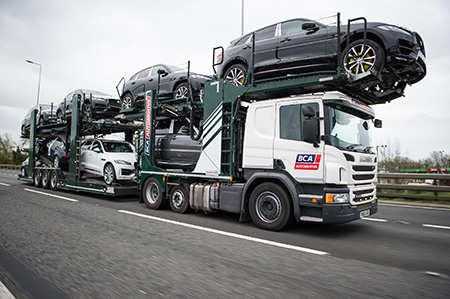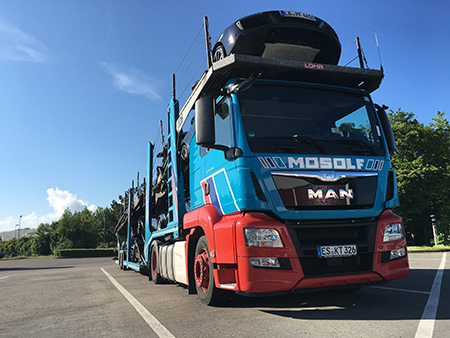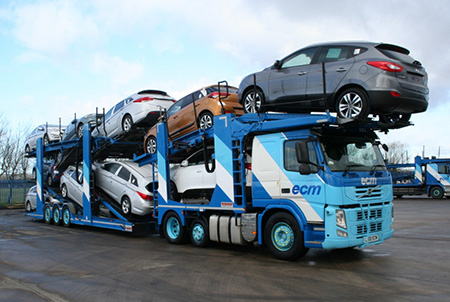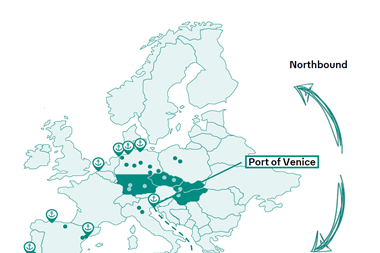 The European new vehicle market has showed strength in recent years, following a long decline after the global financial and subsequent Eurozone crises; sales have mostly recovered to pre-crisis levels and continued to rise in most major EU markets throughout 2017, with the exception of the UK.
The European new vehicle market has showed strength in recent years, following a long decline after the global financial and subsequent Eurozone crises; sales have mostly recovered to pre-crisis levels and continued to rise in most major EU markets throughout 2017, with the exception of the UK.
The outlook for the next few years, however, is for relative stagnation. Forecasting firm PwC Autofacts suggests the market has hit its cyclical high and will move into reverse, in part because of increasing insecurity about regulations, including policy on diesel vehicles, as well as other issues including Brexit.
The changing marketplace has already been driving competition through the vehicle logistics sector, which is likely to continue apace. Considerable consolidation is already underway, with 2017 a notable year, including France’s Groupe CAT making numerous purchases to become the continent’s largest road carrier as well as a major rail provider. The UK has also seen increasing levels of consolidation.
Nevertheless, despite low growth expectations and the possibility of more takeovers, discussions with major players reveal a sense of calm, even in markets facing perhaps the most uncertainty, such as the UK. Many carriers are still investing in improving their fleets and preparing for growth, from better IT systems to greener transport solutions.
 Perhaps that is because carmakers and logistics providers continue to contend with shortages in transport and storage capacity in certain regions and at certain times of the year. However, many executives agree that getting the right equipment in place is not as pressing as finding the right drivers to operate it. At Audi, head of brand logistics Michael Hauf calls the driver shortage the biggest challenge in vehicle logistics across the Volkswagen Group. Many European executives would agree.
Perhaps that is because carmakers and logistics providers continue to contend with shortages in transport and storage capacity in certain regions and at certain times of the year. However, many executives agree that getting the right equipment in place is not as pressing as finding the right drivers to operate it. At Audi, head of brand logistics Michael Hauf calls the driver shortage the biggest challenge in vehicle logistics across the Volkswagen Group. Many European executives would agree.
“It is mainly the driver topic that keeps us busy,” says Wolfgang Göbel, chief sales officer at German vehicle logistics carrier Mosolf Group, who is also president of Brussels-based lobby group the Association of European Vehicle Logistics (ECG).
Although the prospect of autonomous driving and truck platooning could offer a solution to the driver recruitment problem, few executives seem to think this way. Many point out that vehicle logistics requires drivers to carry out secure loading and ensure compliance with legislation and OEM requirements, tasks that cannot easily be automated. Some think an autonomous truck could broaden the scope of a driver’s job even further.
“The expectation is that the job of the driver will be more interesting and we can attract people who are interested in other things besides the driving while on the road,” says Göbel.
“People are our most important asset and represent a vital ingredient in our success,” adds Allen Stuart, commercial and finance director at UK vehicle carrier ECM (Vehicle Delivery Service). “The reality is that our customers, via their appointed dealers/retailers, meet more drivers than any other company representative.”
Companies are instead focused on optimising operations to manage driver or equipment shortages. Manuel Medina, finished vehicle distribution manager at Volkswagen Group brand Seat, thinks one of the most important efficiency gains is to be had in improving vehicle pick-up planning for carriers from plants. With better forecasts, carriers can be more strategic with their assets.
“With this information, suppliers can better plan their fleets, thus improving the empty mileage of their trucks, and also plan the pick-up of cars at the factory almost immediately following manufacture,” he says.
A consolidating marketWhile companies will continue to focus on efficiency, consolidation in the European road sector has gathered pace. Most recently, Groupe CAT took over STVA, a vehicle logistics subsidiary of SNCF, the French national railway. With the purchase, Groupe CAT now has Europe’s largest fleet of car carriers, with 1,700 trucks and a network of 96 logistics centres, along with 2,600 rail wagons. The STVA takeover is the latest in a run of acquisitions the company has made across Europe, including those of Carlson in the UK, Trial in France, Fleetpoint in the Netherlands, VSE in Germany, and Toquero and Sintax in Spain.

In the UK, BCA has bought up Paragon Automotive, Ambrosetti and Stobart Automotive. In 2017, the company restructured its supply chain operations into four divisions to improve support for manufacturers and fleet operators, with BCA Automotive the division handling vehicle logistics, led by managing director Nigel Glenn.
The company currently operates around 800 car carriers, with the majority applied to a mixed-user network between new, used and auction vehicles, which gives it more flexibility in building loads and return flows, says Glenn.
“The model will enable us to manage our investment strategy in line with the market and flatten the traditional cyclical nature of our business,” he says. Only 100 of its trucks are on dedicated operations, for example. In 2017, BCA trucks moved around 2.1m new and remarketed cars, an increase of around 500,000 units compared to 2016, after it incorporated a number of acquisitions.
“The plan for the next three years is to maintain the balanced age profile within the fleet along with a high level of flexibility in both capacities and volumes,” says Glenn. “Our overall fleet has increased by around 200 trucks in the last three years with the remainder being replacement vehicles.”
Glenn also points to potential future growth in continental Europe, where BCA currently operates a sub-contracted model with partner businesses. “That will evolve as the markets change,” he predicts.
In Germany, Mosolf has recently taken complete ownership of SAT Sächsische Autotransport und Service, previously a 50:50 joint venture with Schnellecke Group. The division handles new and used vehicles for manufacturers, dealers and fleet operators, as well as functioning as the releasing agent at the Volkswagen plant in Zwickau-Mosel, Germany. It handles around 545,000 vehicles annually across a number of sites in Germany. In total, Mosolf expects to move around 1.8m vehicles in 2017.
The company has been rebuilding its fleet of carriers back to the 1,000 units it operated before the economic crisis that began in 2008, after which numbers dropped to 700. Göbel says there will be a slight increase in its fleet in 2018, but investment will mainly be on the renewal of existing equipment. “There has been growth and investment in the last years but in 2018 we see this as more or less stable,” he says.
 Germany’s Mosolf has been rebuilding its fleet back to pre-financial crisis levels, but 2018 is predicted to be a year of stability and refreshment rather than huge growth
Germany’s Mosolf has been rebuilding its fleet back to pre-financial crisis levels, but 2018 is predicted to be a year of stability and refreshment rather than huge growthAnother major German provider, ARS Altmann, has also recently acquired companies in Italy and the UK. Altmann has doubled its total fleet over the last three years to 650 units, with plans to increase that number to 1,000 as part of its long-term ‘Strategy 2025’ roadmap, says Michael Bronsert, head of sales. Altmann was on target to handle 4m vehicles in 2017, up from the 3.5m vehicles it moved in 2016.
As well as transport, Bronsert sees storage services increasing as consumers hesitate over new car purchases and whether to buy diesel or electric vehicles, factors driving up vehicle inventories across Europe. “The current uncertainties regarding diesel and electric vehicles indicate an increased interest in storage locations,” he explains. “In order to respond adequately to this growing demand, we are investing in three flagship compounds with around 15,000 parking spaces.”
Despite wider industry consolidation, ECM has relied on continued organic growth for more than 30 years. “Never in the history of the company have we undertaken a merger or acquisition,” says ECM’s Allen Stuart. “We see no reason for our organic growth to cease. However, growth in the future may be at a slower pace due to the expected decline in UK new car registrations.”
ECM has kept a steady annual delivery of 1.3m vehicles over the last two years with a fleet of 520 car transporters. In view of the weaker UK market, the company has reduced its planned capital expenditure for 2018, following three years of substantial investment.
However, Stuart says equipment will still be in high demand in the first half of 2018, when the market in the UK will be more active as a result of legislative changes, including new environmental testing rules and a change in taxation for diesel vehicles; he expects the second half to see a more obvious decline.
Despite uncertainty in Britain, he also points to positive developments for ECM, which recently secured its first contract with Bentley Motors following a bid based on a change in the delivery mode at the carmaker from using enclosed transporters to ‘bulk open’ equipment, which ECM will use to transport Bentleys for export.
Innovative equipmentIf the European vehicle logistics sector is seeing many mergers and acquisitions, its supply base for specialised car-carrying trailers has already consolidated to three manufacturers: France’s Lohr, Italy’s Rolfo and Austria’s Kassböhrer.
"People are our most important asset and represent a vital ingredient in our success. The reality is that our customers, via their appointed dealers/retailers, meet more drivers than any other company representative." - Allen Stuart, ECM
“Vehicle transporter manufacturing represents a niche industry when compared with other forms of transportation equipment,” says Stuart at ECM. “Over time, this has resulted in consolidation of transporter manufacturers, as the marketplace is simply not large enough to support multiple transporter manufacturers in individual countries.”
However, executives say they offer a wide range of variants tailored to requirements. “Collaboration with the manufacturers of car carrier equipment is largely productive,” says Altmann’s Bronsert. “We get good support and the manufacturers are very helpful.”
[mpu_ad]According to Göbel, the suppliers deliver what the market demands and are innovative in their offerings. Stuart agrees that the supply, choice and diversity of equipment are adequate, both for off-the-shelf products and customised designs.
Meanwhile, despite its issues over emissions, diesel looks set to remain the dominant fuel source for European trucks for years to come. However, logistics providers are increasingly looking at alternatives.
“We are replacing existing equipment and carrying out the last steps to be completely compliant with Euro 6,” says Göbel, referring to the EU’s most recent standards. “Then we will make some trials with new technology, such as LNG [liquefied natural gas] trucks.”
Others have already started. Iveco has released a Stralis truck combined with a car transporter unit supplied by Rolfo, which is due to go into service in 2018. The company has 150 LNG trucks providing logistics services and 300 orders on the books, according to Clement Chandon, gas business development manager at the Italian truckmaker. It is also working closely with Fiat Chrysler and its in-house vehicle logistics provider, i-Fast, to use LNG equipment.
Some are looking to electric options as well. ARS Altmann is now using a fully electric truck to move vehicles made at BMW’s Munich plant between BMW Welt, a customer pickup centre next to the plant, and a distribution hub north of the city in Garching. Bronsert says the company will also soon bring an LNG truck into service for vehicle handling.
Despite such progress, the infrastructure to support the wider adoption of electric and LNG trucks is lacking in many European countries, including Germany. “Legislators must make their contribution to making electric and LNG vehicles more attractive for companies,” Bronsert says.
ECM’s Stuart says that the right equipment is simply not available for alternative propulsion in the UK. “Car transporter specifications for electric and hybrid trucks are not available for purchase in the UK market,” says Stuart. “Alternative fuel trucks have been trialled in the past, but have not suited the specific design of a car transporter and ECM’s operating model.”
Legislation across bordersEuropean legislation has a key role to play, both in vehicle logistics productivity and in the attractiveness of the job to drivers. Executives say greater flexibility in weekly rest schedules would improve things for drivers, for example.
“Flexibility would give our drivers the advantage of being able to design their work and leisure time more individually and thus achieve a better work-life balance,” says Bronsert. “The circulations of the trucks could also be better planned and [we could] consequently achieve a significant increase in the efficiency of our processes. We are, therefore, already thinking about new shift models.”
 While transporter manufacturing is a niche, carriers like ECM praise the innovation offered by the main equipment builders in Europe
While transporter manufacturing is a niche, carriers like ECM praise the innovation offered by the main equipment builders in EuropeHowever, regulations governing driving and rest periods have placed restrictions on carriers, claim executives. While safety is a priority, they complain that rules introduced in 2017, which prohibit drivers from spending their weekly rest period in their cabs, have led to more administrative efforts and higher costs.
International rules for trucking operations and employment are important issues, including legislation on cabotage – local transport by an operator in a country or countries other than the one in which it is registered – and on driver wages. For example, some countries apply national minimum wages, including Germany, the Netherlands, France and Austria; Germany has also required foreign companies engaged in cabotage activities to pay drivers this rate within the country, a practice that the European Commission (EC) has opposed.
Under the EC’s latest proposals, known as the ‘posted worker directive’ and backed strongly by French president Emmanuel Macron, truck drivers would be able to move outside the EU member state in which they reside and still be paid according to the rules of their home country for up to three days; any longer and they would fall under the local rules of the country in which they are delivering the goods. The proposals are particularly controversial for lower wage countries in eastern Europe, while some in western Europe say they don’t do enough to restrict ‘social dumping’.
There are also proposed changes to cabotage. Under current rules, an operator in another EU state is restricted to three cabotage movements in seven days. Under new proposals, a foreign company could carry out as many cabotage operations as it needed for five days in other member states. Given that cabotage overall represents 2% of the national transport activity in Europe, the EC has suggested the simplification of the rules would have no major impact on business. However, that percentage is likely to be higher for some finished vehicle logistics providers, especially those in and around central Europe who move more frequently through various countries.
Carriers are cautious in their response to the new proposals. According to Altmann’s Bronsert, it could open up markets and offer the company new business opportunities. “On the other hand, this would also lead to many foreign companies competing with existing players on the market. Eastern European companies, in particular, could have a lasting impact on the market due to the usually lower fixed costs,” he says.
At Mosolf, the impact of any change to the cabotage regulations will have only a peripheral impact as the company’s fleet is based mainly in Germany and registered there, says Göbel. Mosolf has a relatively low number of car carriers operating from the Czech Republic, for example, though its subsidiary in Poland operates under cabotage rules.
There are concerns over how the new rules would be applied, including when the active period would start and what proof carriers would have to show officials about their work in different member states. Electronic documents could be introduced, however, electronic transport and liability consignment notes (eCMRs) do not currently contain all of the elements that have been listed in the proposal. Also, only a minority of EU member states currently use eCMRs.
 ARS Altmann is using an electric carrier to move vehicles from a customer pick-up centre near BMW’s Munich plant and a distribution centre in Garching
ARS Altmann is using an electric carrier to move vehicles from a customer pick-up centre near BMW’s Munich plant and a distribution centre in GarchingThe EC is also discussing the introduction of a fully interoperable toll payment system via the European Electronic Toll Service (EETS), with road users subscribing to a single contract with an EETS provider for payments associated with any charging scheme that requires on-board equipment.
This is something that would make sense, according to Göbel, but he says it will be tricky to agree a joint system to calculate and charge high fees, while the calculation would have to depend on things like truck emissions and the time of the day or night the vehicle was travelling.
“At least the functionality of the on-board units in the truck should be harmonised, so we are not carrying all kinds of devices just to pay the toll in the correct way,” says Göbel. “This is highly appreciated and would be something that made life easier for us and for the drivers.”
A longer-term outlookThe European vehicle logistics sector has been through hard times and could be facing more as the market heads towards slower growth or even cyclical decline. Uncertainty over Brexit and broader political instability, whether in Spain, eastern Europe or even Germany, may compound such issues. Rising vehicle inventories in ports and compounds are also a foreboding sign for many who remember the financial crash a decade ago.
The future presents other challenges. The expected growth in electric vehicles raises questions over charging points at compounds and ports, as well as equipment; battery electric vehicles, for example, are significantly heavier than vehicles with combustion engines, which could have implications for load factors and regulations.
[related_topics align="right" border="yes"]Such prospects emphasise the importance of carmakers and logistics providers working closely together. Luckily, executives highlight improving relationships. Göbel points to positive dialogue and working groups between carmakers and logistics providers through the ECG. He and others also say more carmakers are interested in longer-term contracts.
“One of the key items for the future is to be able to have a long-term approach for these contracts in terms of investment and generating the efficiencies that are possible beyond one or two-year contracts,” he says.
Seat’s Manuel Medina points to contracts that typically last three or even five years. BCA’s Nigel Glenn says several of BCA’s OEM customers have moved to longer contracts, which have enabled the company to continue investment. ECM’s Stuart also points to progress. “The OEM sourcing process is becoming more evenly balanced across the key factors of quality, cost, delivery, management innovation and environment,” he confirms.
"[Proposed changes to cabotage could] lead to many foreign companies competing with existing players on the market. Eastern European companies, in particular, could have a lasting impact on the market due to the usually lower fixed costs." - Michael Bronsert, ARS Altmann
Topics
- Ambrosetti
- ARS Altmann
- Association of European Vehicle Logistics
- Audi
- Austria
- BCA
- Bentley
- BMW
- BMW
- Carlson
- Czech Republic
- ECG
- ECM
- Europe
- features
- Fiat Chrysler
- Finished Vehicle Logistics
- Fleetpoint
- France
- Germany
- Groupe Cat
- i-Fast
- Inventory management
- Iveco
- Kassböhrer
- Lohr
- Mosolf Group
- Netherlands
- Paragon Automotive
- Poland
- Policy and regulation
- PwC Autofacts
- Road
- Rolfo
- SAT Sächsische Autotransport und Service
- Schnellecke Group
- seat
- Sintax
- SNCF
- Spain
- Stobart Automotive
- STVA
- Supply Chain Planning
- Toquero
- trial
- United Kingdom
- Volkswagen
- VSE

































